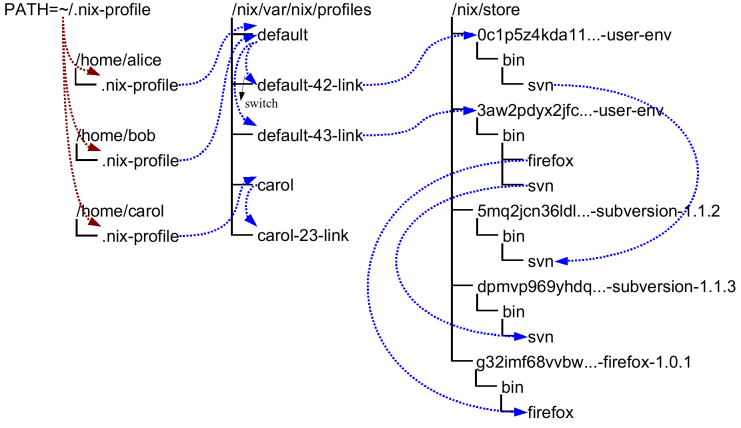e.g. nix-env -e subversion => nix-env --uninstall subversion The aim is to make the documentation less cryptic for newcomers and the long options are more self-documenting. The change was made with the following script: <https://github.com/aschmolck/convert-short-nix-opts-to-long-ones> and sanity checked visually.
5.4 KiB
Profiles
Profiles and user environments are Nix’s mechanism for implementing the
ability to allow different users to have different configurations, and
to do atomic upgrades and rollbacks. To understand how they work, it’s
useful to know a bit about how Nix works. In Nix, packages are stored in
unique locations in the Nix store (typically, /nix/store). For
instance, a particular version of the Subversion package might be stored
in a directory
/nix/store/dpmvp969yhdqs7lm2r1a3gng7pyq6vy4-subversion-1.1.3/, while
another version might be stored in
/nix/store/5mq2jcn36ldlmh93yj1n8s9c95pj7c5s-subversion-1.1.2. The long
strings prefixed to the directory names are cryptographic hashes (to be
precise, 160-bit truncations of SHA-256 hashes encoded in a base-32
notation) of all inputs involved in building the package — sources,
dependencies, compiler flags, and so on. So if two packages differ in
any way, they end up in different locations in the file system, so they
don’t interfere with each other. Here is what a part of a typical Nix
store looks like:
Of course, you wouldn’t want to type
$ /nix/store/dpmvp969yhdq...-subversion-1.1.3/bin/svn
every time you want to run Subversion. Of course we could set up the
PATH environment variable to include the bin directory of every
package we want to use, but this is not very convenient since changing
PATH doesn’t take effect for already existing processes. The solution
Nix uses is to create directory trees of symlinks to activated
packages. These are called user environments and they are packages
themselves (though automatically generated by nix-env), so they too
reside in the Nix store. For instance, in the figure above, the user
environment /nix/store/0c1p5z4kda11...-user-env contains a symlink to
just Subversion 1.1.2 (arrows in the figure indicate symlinks). This
would be what we would obtain if we had done
$ nix-env --install --attr nixpkgs.subversion
on a set of Nix expressions that contained Subversion 1.1.2.
This doesn’t in itself solve the problem, of course; you wouldn’t want
to type /nix/store/0c1p5z4kda11...-user-env/bin/svn either. That’s why
there are symlinks outside of the store that point to the user
environments in the store; for instance, the symlinks default-42-link
and default-43-link in the example. These are called generations
since every time you perform a nix-env operation, a new user
environment is generated based on the current one. For instance,
generation 43 was created from generation 42 when we did
$ nix-env --install --attr nixpkgs.subversion nixpkgs.firefox
on a set of Nix expressions that contained Firefox and a new version of Subversion.
Generations are grouped together into profiles so that different users don’t interfere with each other if they don’t want to. For example:
$ ls -l /nix/var/nix/profiles/
...
lrwxrwxrwx 1 eelco ... default-42-link -> /nix/store/0c1p5z4kda11...-user-env
lrwxrwxrwx 1 eelco ... default-43-link -> /nix/store/3aw2pdyx2jfc...-user-env
lrwxrwxrwx 1 eelco ... default -> default-43-link
This shows a profile called default. The file default itself is
actually a symlink that points to the current generation. When we do a
nix-env operation, a new user environment and generation link are
created based on the current one, and finally the default symlink is
made to point at the new generation. This last step is atomic on Unix,
which explains how we can do atomic upgrades. (Note that the
building/installing of new packages doesn’t interfere in any way with
old packages, since they are stored in different locations in the Nix
store.)
If you find that you want to undo a nix-env operation, you can just do
$ nix-env --rollback
which will just make the current generation link point at the previous
link. E.g., default would be made to point at default-42-link. You
can also switch to a specific generation:
$ nix-env --switch-generation 43
which in this example would roll forward to generation 43 again. You can also see all available generations:
$ nix-env --list-generations
You generally wouldn’t have /nix/var/nix/profiles/some-profile/bin in
your PATH. Rather, there is a symlink ~/.nix-profile that points to
your current profile. This means that you should put
~/.nix-profile/bin in your PATH (and indeed, that’s what the
initialisation script /nix/etc/profile.d/nix.sh does). This makes it
easier to switch to a different profile. You can do that using the
command nix-env --switch-profile:
$ nix-env --switch-profile /nix/var/nix/profiles/my-profile
$ nix-env --switch-profile /nix/var/nix/profiles/default
These commands switch to the my-profile and default profile,
respectively. If the profile doesn’t exist, it will be created
automatically. You should be careful about storing a profile in another
location than the profiles directory, since otherwise it might not be
used as a root of the garbage collector.
All nix-env operations work on the profile pointed to by
~/.nix-profile, but you can override this using the --profile option
(abbreviation -p):
$ nix-env --profile /nix/var/nix/profiles/other-profile --install --attr nixpkgs.subversion
This will not change the ~/.nix-profile symlink.
